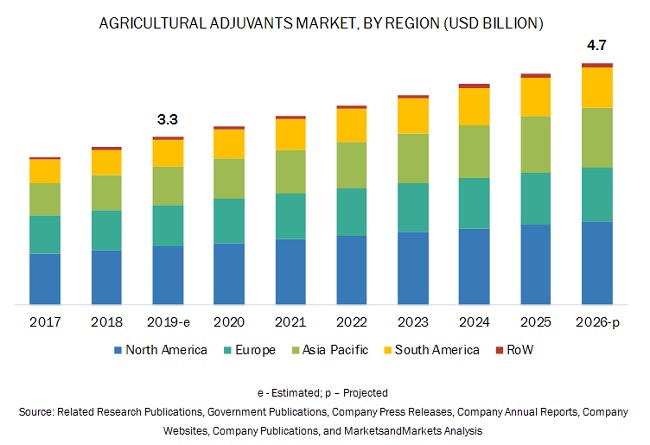The agricultural adjuvants market is projected to reach USD 4.7 billion by 2026, growing at a CAGR of 5.3% from 2019. The growth of the agricultural adjuvants market is driven by factors such as the growing demand for agrochemicals and the adoption of protected agriculture technologies.

Report Objectives:
- To define, segment, and project the global market size of the agricultural adjuvants market.
- To understand the agricultural adjuvants market by identifying its various subsegments
- To provide detailed information about the key factors influencing the growth of the market (drivers, restraints, opportunities, and industry-specific challenges)
- To analyze the micromarkets with respect to individual growth trends, future prospects, and their contribution to the total market
- To project the size of the market and its submarkets, in terms of value, with respect to the regions (along with their respective key countries)
Download PDF Brochure: https://www.marketsandmarkets.com/pdfdownloadNew.asp?id=1240
Adjuvants for biological products:
Adjuvants are mostly added to synthetic pesticides to improve their performance. However, these adjuvants undergo strict regulations and require high investment for production. Hence, there is a need to develop adjuvants that can be used in biological products such as biopesticides and biostimulants.
Adjuvant manufacturing companies are constantly adapting to the changing demands by developing novel products and technologies. With the increasing awareness of eco-friendly and sustainable products, the necessity to develop adjuvants that can be compatible with biological products has been increasingly realized. Sustainable and non-oil adjuvants are required to maintain the viability and pesticidal efficiency of agricultural biologicals such as biostimulants and biofertilizers.
The increasing demand for improved varieties in crops in the Asia Pacific regions is driving the growth of the agricultural adjuvants market.
Asia Pacific comprises of developing countries with vast agricultural lands; the per capita income of the region depends on agricultural activities. Agricultural technologies are widely accepted and practiced in this region. In Asia Pacific, the total area under agriculture is shrinking due to the high rate of industrialization and urbanization. As a result, farmers opt for practices such as the use of chemical pesticides, which help to increase the yield or productivity of crops.
Make an Inquiry: https://www.marketsandmarkets.com/Enquiry_Before_BuyingNew.asp?id=1240
Key players in the agricultural adjuvants market include Solvay (Belgium), Evonik Industries (Germany), Nufarm (Australia), and Croda International (UK), Corteva Inc. (US), and BASF (Germany). Product innovation, expansions & investments, mergers & acquisitions, joint ventures, and agreements, collaborations, joint ventures, disinvestments, and partnerships were some of the core strengths of the leading players in the agricultural adjuvants market. These strategies were adopted by the key players to increase their market presence. It also helped them diversify their businesses geographically, strengthen their distribution networks, and enhance their product portfolios. Some of the other leading players in the agricultural adjuvants include Miller Chemical and Fertilizer, LLC (US), Precision Laboratories (US), CHS Inc (US), Winfield United (US), Kalo Inc. (US), Nouryon (Netherlands), Huntsman Corporation (US), Clariant (US), Helena Agri-Enterprises (US), Stepan Company (US), Wilbur-Ellis Company (US), Brandt (US), Plant Health Technologies (US), and Innvictis Crop Care (US).

